public transit systems available to help you get where you want to go.
Underground subway systems offer the convenience of getting where
you want when you want without the hassle of having to flag down a
taxi or rent a car. In just about all cases, it's the most cost effective option.
There are some beautiful, modern, and vast rapid transit systems
throughout the world. The most popular and diverse international
underground transit systems are listed below, but are merely a
sample of the quite eye-catching transit systems that exist throughout the world.
1. London, England
The London Underground is Europe's largest metro subway systemand is the world's oldest underground system (it was inaugurated in 1863).
It covers 253 miles of track and transports 976 million people yearly.
The Underground is also connected to a variety of rail services to
London's surrounding areas (including the Eurostar to Paris). Among
these services is the Docklands Light Railway (DLR), a popular driverless
light rail extension, which offers many scenic views of the Thames river and surrounding areas.
Highlights: Cushioned seats. LED time displays hanging from the ceiling
in stations indicate the number of minutes you need to wait before the
next train. Eclectic station artwork (such as this January 1st photograph of the Gloucester Road station). Oyster cards allow you to touch against a subway turnstile and go -- and you can pay as you ride.

The London Tube. Photo taken by Brian Weinberg.

The Docklands Light Rail by Canary Wharf, London. Photo taken by Brian Weinberg.
[Photo montage of a typical, yet scenic, commute on the London tube stystem.]
2. Paris, France
The Paris subway system is the second oldest in the world (the initial system was completed in 1900) and aids roughly 1.365 billion people with their daily commutes. Running over 133.7 miles of track and stopping at 380 stations, it has a great amount of coverage throughout the city. Highlights: Excellent coverage: every building in the city is within 500 meters (1600 feet) of a subway station. Many stations were designed with the distinctive unique art noveau style. Modest fares.
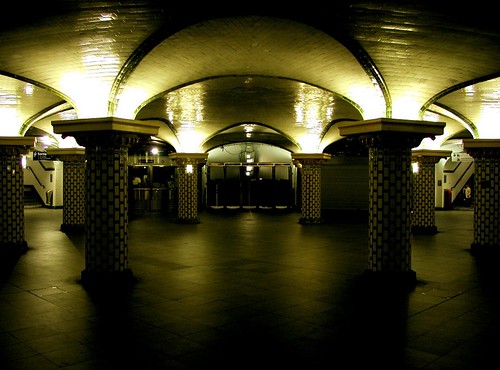
underground symmetry II. Photo taken by phil h.
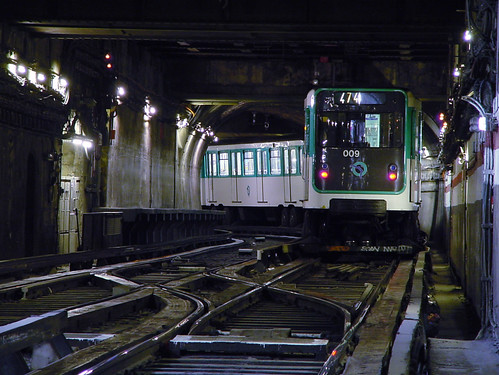
Making choices. Photo taken by manu_le_manu.
[Family video of Paris views of Paris and subway coverage.]
3. Moscow, Russia
The Moscow subway system has the biggest ridership of all metro systems throughout the world, with 3.2 billion riders annually traveling on 12 subway lines to 172 stations. In total, the Moscow Metro covers approximately 178 miles. On an average weekday, the subway itself carries about 8.2 million passengers. While most of the Moscow trains run underground, some lines cross bridges and provide scenic views of the Moskva River and the Yauza River. Highlights: Ornate architecture (at least 44 of these stations are rated as architectural sights). The system has many trains that stop frequently (trains stop at stations approximately every 90 seconds during peak hours). Fastest worldwide system (120km/h or 75mph).
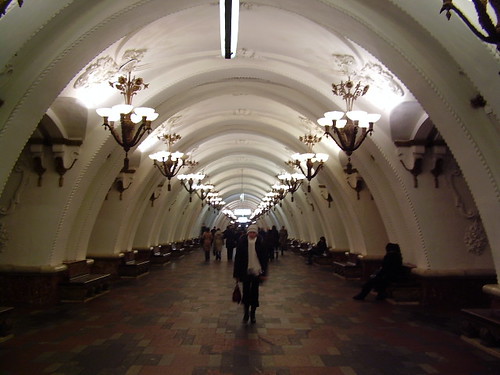
Moscow Metro. Photo taken by borya.
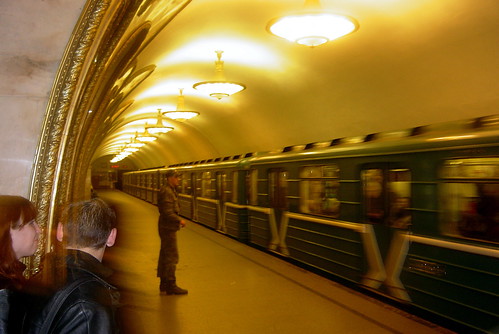
Platform Novoslobodskaya metro station in Moscow. Photo taken by davesag.
[Informational video about the Moscow subway system, with English subtitles]
4. Madrid, Spain
The Madrid Metro is the second largest underground system in Europe and the sixth largest system in the world. It has 141.7 miles of track and an additional 27.5 miles are expected to be completed by the end of this year. The Madrid Metro is the densest metro network in the world. Highlights: Very clean and is implementing an ecologic cleaning system. Fast rides. Affordable fares. Great progress in system expansion (47 miles of new subway lines were built between 1999 and 2003). Modern stations.
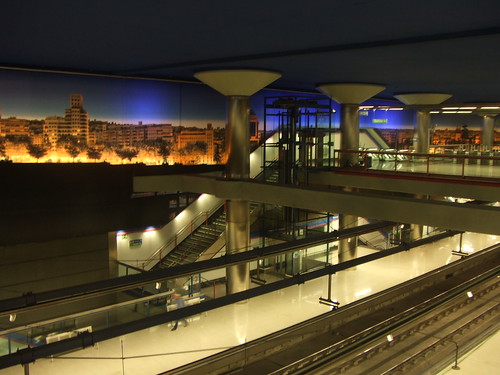
nuevos ministerios metro station. Photo taken by davidkane.
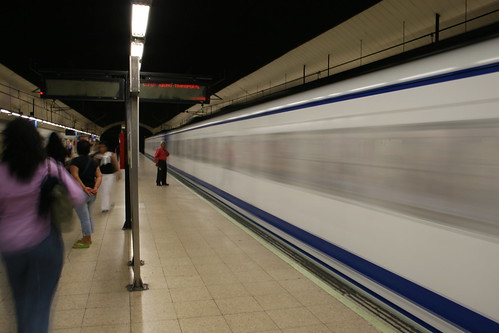
moooove. Photo taken by _guu_.
[An advertisement for the Madrid Metro]
5. Tokyo, Japan
The Tokyo subway system carries approximately 2.8 billion people per year to 282 subway stations. In addition to underground subways, the Tokyo transit system consists of the Toden Arakawa light rail line and the Ueno Zoo Monorail. Highlights: Extremely clean. Trains are on time. The seats are heated. Trains always stop in the same place alongside markers. Subway stops are announced in both Japanese and English. Modern system. The system has underground malls and customer amenities.
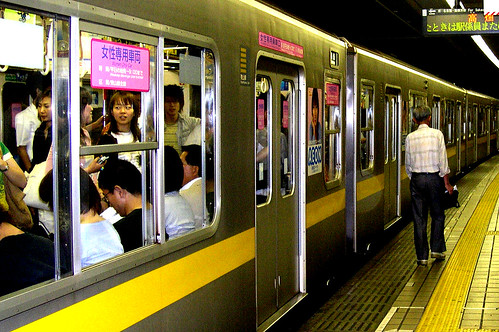
Tokyo, Japan. Photo taken by CW371.

Shimbashi from Dai-Ichi hotel. Photo taken by garyhymes.
[Video of the overcrowding on Tokyo trains.]
6. Seoul, Korea
The Seoul Metropolitan Subway is one of the most heavily used subway systems in the world with more than 8 million daily trips. It is also one of the biggest subway stations worldwide, running 179.4 miles in length. The trains mostly run underground, but 30% of the system is above ground. Highlights: Beautiful architecture. Growth of the system has been incredible over the past few years. Utilizes T-money, a prepaid transportation card for transport throughout the city.
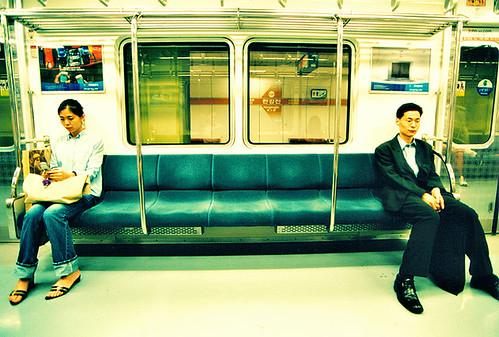
Koreans apart Subway. Photo taken by jeremyallen35.
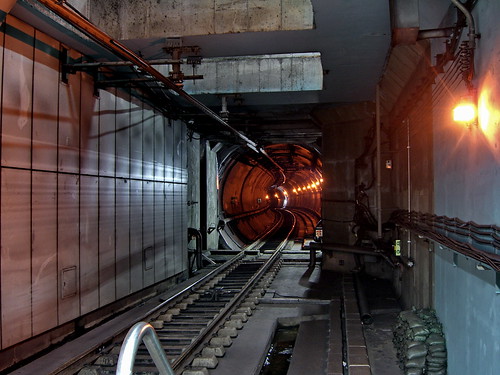
Korean subway tunnel. Photo taken by mikeswe.
[A view of a commute as a train travels from one station to another in Seoul.]
7. New York City, USA
The New York City rapid transit system is one of the most extensive public transit systems worldwide. It has grown from 28 stations when it was founded in October of 1904 to 462 stations presently. The subway carries 4.9 million people daily. Highlights: Offers express services that run on separate tracks from local trains. The MTA is currently testing out LED displays in subway stations to let commuters know when the next train is expected to arrive. 24 hour service. Unique and distinct artwork (mosaics) throughout the system.

NYC Platform Subway. Photo taken by Brian Weinberg.

Modern L Train. Photo taken by Brian Weinberg.
[On-subway Elvis entertainment.]
8. Montreal, Canada
The Montreal Metro is a modern system that was inaugurated in 1966. It is a small (37.8 miles reaching 65 stations on four lines) yet unique and modern system that was inspired by the Paris Metro. Highlights: Diverse, beautiful architecture and unique station art (each station is designed by a different architect). Pleasant riding experience (smooth rides: the trains run on a rubber surface to reduce the screech of train cars). Trains are frequent and fairly comfortable.
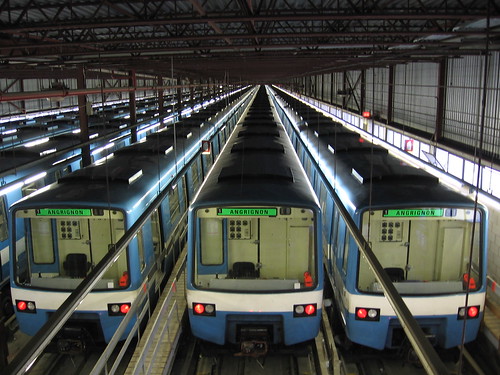
Montreal Metro. Photo taken by F-i-L.

metro tunnel 1. Photo taken by Flowizm.
[Musicians playing within a modern Montreal Metro station.]
9. Beijing, China
The Beijing Subway is a relatively new subway system that opened in 1969 and serves Beijing and the surrounding suburbs. It is currently being expanded upon in a 7.69 billion USD (63.8 billion yuan) project to prepare for the 2008 Olympic Games. The expansion project is expected to bring the current length of the subway station from approximately 71 miles to nearly 300 miles.Highlights: Fairly easy subway to navigate (especially if you're a foreigner). Cheap fare (3 yen for most trips). Interesting architecture on the newer subway lines. A very ambitious expansion project is in the works.
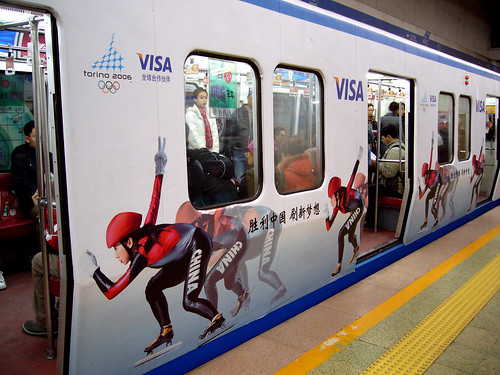
Next stop, Torino. Photo taken by xiaming.

xie yan. Photo taken by jiankun.
10. Hong Kong
The Hong Kong subway, also known as the Mass Transit Railway (which translates to "underground railway" in English), was established in 1979. Despite its relatively small size compared (56 miles) to other transit systems, the MTR transports an average of 2.46 million rides per day. The Hong Kong system is based on a British design. Highlights: Efficient. Frequent service, High-capacity cars. Extremely affordable. Clean and modern system with air-conditioned cars. Uses the Octopus contactless smart card for subway currency, allowing travelers to swipe their card near the turnstile for easy access to train platforms.
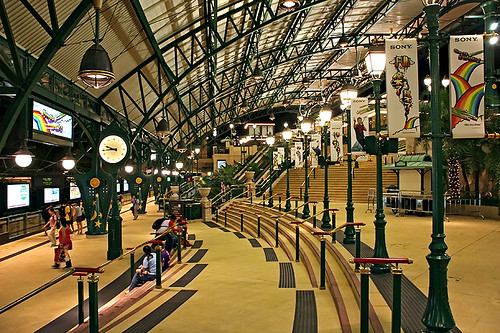
Disney MTR Station. Photo taken by ianong.

Hong Kong MTR 2007. Photo taken by Michael Kwokstyle.
[A view of a modern-style Hong Kong train from outside and then inside.]
11. Sao Paulo, Brazil
The Sao Paulo Metro is the first underground transit system in Brazil. It works alongside a larger company called the Companhia Paulista de Trens Metropolitanos (CPTM) and together they cover 187 miles of track and transport approximately 3.7 million people daily. Highlights: Known as one of the cleanest and safest systems in the world. Affordable fare.

R. Pamplona, Al. Casa Branca. Photo taken by Elton Melo.

Untitled. Photo taken by Rubira
No comments:
Post a Comment